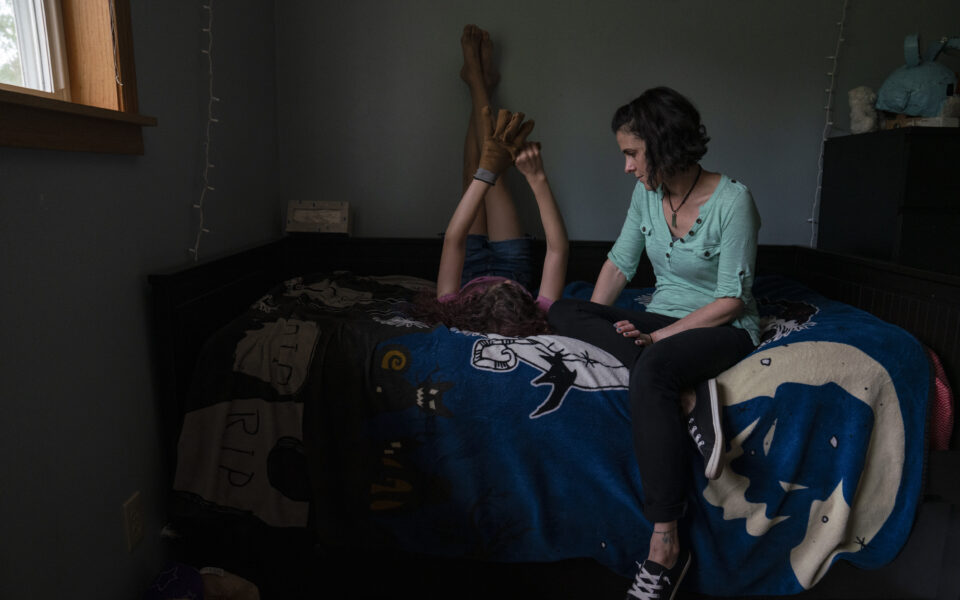They paused puberty, but is there a cost?

The medical guidance was direct. Eleven-year-old Emma Basques had identified as a girl since toddlerhood. Now, as she worried about male puberty starting, a Phoenix pediatrician advised: Take a drug to stop it.
At 13, Jacy Chavira felt increasingly uncomfortable with her maturing body and was beginning to believe she was a boy. Use the drug, her endocrinologist in Southern California recommended, and puberty would be suspended.
An 11-year-old in New York with deepening depression expressed a desire to no longer be a girl. A therapist told the family the drug was the preteen’s best option, and a local doctor agreed.
“‘Puberty blockers really help kids like this,’” the child’s mother recalled the therapist saying. “It was presented as a tourniquet that would stop the hemorrhaging.”
As the number of adolescents who identify as transgender grows, drugs known as puberty blockers have become the first line of intervention for the youngest ones seeking medical treatment.
Their use is typically framed as a safe – and reversible – way to buy time to weigh a medical transition and avoid the anguish of growing into a body that feels wrong. Transgender adolescents suffer from disproportionately high rates of depression and other mental health issues. Studies show that the drugs have eased some patients’ gender dysphoria – a distress over the mismatch of their birth sex and gender identity.
“Anxiety drains away,” said Dr. Norman Spack, who pioneered the use of puberty blockers for trans youths in the United States and is one of many physicians who believe the drugs can be lifesaving. “You can see these kids being so relieved.”
But as an increasing number of adolescents identify as transgender – in the United States, an estimated 300,000 ages 13-17 and an untold number who are younger – concerns are growing among some medical professionals about the consequences of the drugs, a New York Times examination found. The questions are fueling government reviews in Europe, prompting a push for more research and leading some prominent specialists to reconsider at what age to prescribe them and for how long. A small number of doctors won’t recommend them at all.
Dutch doctors first offered puberty blockers to transgender adolescents three decades ago, typically following up with hormone treatment to help patients transition. Since then, the practice has spread to other countries, with varying protocols, little documentation of outcomes and no government approval of the drugs for that use, including by the U.S. Food and Drug Administration.
But there is emerging evidence of potential harm from using blockers, according to reviews of scientific papers and interviews with more than 50 doctors and academic experts around the world.
The drugs suppress estrogen and testosterone, hormones that help develop the reproductive system but also affect the bones, the brain and other parts of the body.
During puberty, bone mass typically surges, determining a lifetime of bone health. When adolescents are using blockers, bone density growth flatlines, on average, according to an analysis commissioned by the Times of observational studies examining the effects.
Many doctors treating trans patients believe they will recover that loss when they go off blockers. But two studies from the analysis that tracked trans patients’ bone strength while using blockers and through the first years of sex hormone treatment found that many do not fully rebound and lag behind their peers.
That could lead to heightened risk of debilitating fractures earlier than would be expected from normal aging – in their 50s instead of 60s – and more immediate harm for patients who start treatment with already weak bones, experts say.
“There’s going to be a price,” said Dr. Sundeep Khosla, who leads a bone research lab at the Mayo Clinic. “And the price is probably going to be some deficit in skeletal mass.”
Many physicians in the United States and elsewhere are prescribing blockers to patients at the first stage of puberty – as early as age 8 – and allowing them to progress to sex hormones as soon as 12 or 13. Starting treatment at young ages, they believe, helps patients become better aligned physically with their gender identity and helps protect their bones.
But that could force life-altering choices, other doctors warn, before patients know who they really are. Puberty can help clarify gender, the doctors say – for some adolescents reinforcing their sex at birth, and for others confirming that they are transgender.
Long-awaited research funded by the National Institutes of Health could provide more guidance. In 2015, four prominent American gender clinics were awarded $7 million to examine the effects of blockers and hormone treatment on transgender youths. In explaining their study, the researchers pointed out that the United States had produced no data on the impact or safety of blockers, particularly among transgender patients younger than 12, leaving a “gap in evidence for this practice.” Seven years in, they have yet to report key outcomes of their work, but say the findings are coming soon.
Many young patients and their families have concluded that the benefits of easing the despair of gender dysphoria far outweigh the risks of taking blockers. For others, the limited studies and politicization of trans medicine can make it difficult to fully evaluate the decision.
Three years after starting the drugs, Emma Basques believes she’s on the right path.
Jacy Chavira, now 22, decided that the medical treatment was not appropriate for her and resumed her female identity.
And the New York adolescent had such a significant loss in bone density after more than two years on blockers that the parents halted use of the drugs.
‘Time to Start’
It didn’t take long for Cherise and Arick Basques to realize that their toddler was different. The child rejected pants, toy trucks and sports in favor of dresses, Barbie dolls and ballet. When Cherise Basques ran into a friend at a restaurant in their Phoenix suburb and introduced her then-4-year-old as her son, the child shouted: “No! I’m your daughter!”
The couple worked with children – Cherise Basques as an occupational therapist, her husband as a teacher and school administrator – but this was unfamiliar territory. None of the therapists the parents called felt equipped to help. Their pediatrician offered only that things could change once the child started school, the mother said. Eventually, the couple discovered a local support group for parents of transgender children.
The next year, they allowed the child, then 5, to begin using the name Emma, grow longer hair and take other steps to socially transition. In 2019, when Emma turned 11, a physician at a local gender clinic advised starting blockers.
“At the first subtle signs of puberty, it was like: ‘Yep, that’s it. Time to start!’” recalled Cherise Basques.
For decades, transgender medical treatment in multiple countries was restricted to patients 18 and older. But in the 1990s, a hospital clinic in Amsterdam began treating adolescents.
Puberty blockers can be given as an injection or an implant. (The best known is Lupron, made by AbbVie.)
The first trans patient treated with blockers, from age 13 to 18, moved on to testosterone, the male sex hormone. Halting female puberty had offered emotional relief and helped him look more masculine. As the Dutch clinicians prescribed blockers, followed by hormones, to a half-dozen other patients in those early years, the medical team found their mental health and well-being improved.
“They were usually coming in very miserable, feeling like an outsider in school, depressed or anxious,” recalled Dr. Peggy Cohen-Kettenis, a retired psychologist at the clinic. “And then you start to do this treatment, and a few years later, you see them blossoming.”
In 1998, she worked with a small international group – which would later expand and become known as the World Professional Association for Transgender Health, or WPATH – to include puberty blockers and hormones for adolescents in their treatment guidelines.
The Dutch doctors had yet to publish any research findings. Some other physicians were wary of potential harm.
But doctors in the group considered the early results from Amsterdam as reassuring enough to move forward.
Doctors debated about whether “starting the puberty blockers would somehow damage the children,” recalled Dr. Walter Meyer, a Texas pediatric endocrinologist and psychiatrist involved with the 1998 standards of care.
“The Dutch were saying, ‘Oh, no, it’s not causing a problem,’” said Meyer, who continues to support the use of the drugs.
By the time Emma Basques began taking blockers in 2019, multiple medical groups had endorsed their use for gender dysphoria. Among them were the American Academy of Pediatrics and the international Endocrine Society, which in 2017 had described the limited research on the effects of the drugs on trans youths as “low quality.” Still, the organizations were encouraged by what they saw as a promising treatment.
Some leading American practitioners asked AbbVie and Endo Pharmaceuticals, maker of another blocker, to seek FDA approval for use of the drugs among trans adolescents. The drugmakers would have to fund research for a patient population that made up just a small part of their market. But the physicians argued that regulatory approval could help establish the safety of the treatment and broaden insurance coverage of the drugs, which can cost tens of thousands of dollars a year. In the end, AbbVie and Endo said no.
Emma Basques was on blockers for two years. Then, after she turned 13 in October 2021, a doctor in the Portland, Oregon, suburb where her family had moved, prescribed estrogen, starting her transition. It had become increasingly awkward to feel left behind as her classmates physically matured. And she felt confident that she was ready.
“It was just really exciting,” Emma said. “I finally got to be who I was.”
‘We Need to Give This a Chance’
The 11-year-old in New York, who had begun puberty and started at a new school, was increasingly distressed – refusing to bathe or go to class and, for the first time, expressing a desire to no longer have a girl’s body.
When the parents consented to blockers in 2018, they hoped the drug would bring emotional stability and time to consider next steps.
“If everyone thinks this will help, and it’s reversible, then we need to give this a chance,” said the mother.
The first two years were promising, with the patient, by then a teen, taking Prozac in addition to the blockers. But at the start of the third year, a bone scan was alarming. During treatment, the teen’s bone density plummeted from average levels to the range of osteoporosis, a condition of weakened bones more common in older adults.
The doctor recommended starting testosterone, explaining that it would help the teen regain bone strength. But the parents had lost faith in the medical counsel.
“I was furious,” the mother recalled. “I’m thinking, ‘I worry we’ve done permanent damage.’”
Emma Basques takes calcium, makes an effort to exercise and has undergone scans that showed her bones are healthy. “I can’t even imagine how life would be for Emma,” said her mother, “if she was not given blockers and had to go through male puberty.”
Emma added: “I wouldn’t like my body at all.”
But the parents in New York insisted on ending treatment for their teen, who has yet to have a follow-up scan to see if bone density has improved since going off blockers.
“I don’t think we have the science behind them to be prescribing these drugs,” the mother said.
‘I Wish There Had Been More Questions’
Jacy Chavira, in Grand Terrace, California, had already cut her hair short and begun binding her chest when she was prescribed blockers at age 13. A therapist and her parents agreed that gender dysphoria, a condition Jacy learned about from a magazine, could explain the mounting anxiety and discomfort that she was experiencing during early puberty.
Once on blockers, Chavira said she became fixated on moving ahead with a medical transition. She was thrilled shortly after turning 16 when her pediatric endocrinologist prescribed testosterone. But soon she started having doubts. Her body was growing more masculine, but she was secretly putting on dresses. At 17, in a consultation for breast removal, she worried aloud about the potential loss of feeling in the nipples. To her, this was a sign of not wanting to go through with the surgery.
She came to realize that her anguish had stemmed from a larger inner conflict, and that continuing with a gender transition would be a mistake. “I believe it was an issue with my identity, accepting who I was, and not just the physical female portion of it,” she said.
Like Chavira, most patients who take puberty blockers move on to hormones to transition – as many as 98% in British and Dutch studies. While many doctors see that as evidence that the right adolescents are getting the drugs, others worry that some young people are being swept into medical interventions too soon.
Over the past decade, growing numbers of treatment providers have lowered the ages at which they prescribe drugs. Today, the WPATH and Endocrine Society advise that blockers can be prescribed at the first signs of puberty and hormone treatment, in some cases, earlier than 16. The American Academy of Pediatrics says blockers can be provided anytime during puberty and hormones from “early adolescence onward.”
Some doctors and researchers are concerned that puberty blockers may somehow disrupt a formative period of mental growth. With adolescence comes critical thinking, more sophisticated self-reflection and other significant leaps in brain development. Sex hormones have been shown to affect social and problem-solving skills. It’s believed that brain growth is connected to gender identity, but research in these areas is still very new.
Jacy Chavira, looking back on her own experience, thinks that drugs were prescribed too quickly. At 18, she halted her medical treatment and resumed her female identity. Now, she is left with a voice that sounds like a man’s and other enduring physical changes.
“I wish there had been more questions asked by the doctors,” she said. “I wish I hadn’t been steered into transitioning the way I was, and that I had been told there were other ways to cope with the discomfort of puberty.”
More than a dozen doctors declined to be interviewed for this article, and several who spoke to the Times – some who support treatment, others who question it – asked not to be named.
The climate could have a chilling effect on research, said Dr. Natalie Nokoff, assistant professor of pediatric endocrinology at the University of Colorado, who recently conducted a soon-to-be-published study showing that a longer treatment period on puberty blockers was associated with a lower bone density.
“It’s leading to concerns that people’s well-intentioned scientific research could be misconstrued” and exploited for political gain, she said.
The prospect of such an outcome is disheartening for the families of Emma Basques, Chavira and the teen in New York. Despite their differing experiences, they share the same hopes for transgender medicine: less vitriol, more science.
This article originally appeared in The New York Times.






